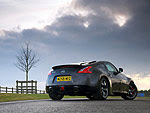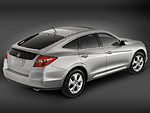No Wonder They Beat The U.S. Team!
Actually, the medal ceremony for women's hockey was very nice, as the mostly Canadian crowd changed USA! USA! after the American team was awarded the silver medal. It was generous, considering that the Canadians had been beaten in men's hockey by the U.S.
In Defense of ETC Part 2; Professor Gilbert's Test
Gilbert's testing discovered a hole in Toyota's diagnostics for their ETC system. To fool the system, he had to induce a highly unlikely failure. Toyota's system uses two pedal position sensors, which are separated by several centimeters, which have signal wires coming out on a common harness. Gilbert shorted the signal wires of the two sensors together through a resistor. By carefully choosing the resistor, he was able to find a short combination which the Toyota diagnostics did not detect. However, a short alone was not enough to cause unintended acceleration. To do that, Gilbert had to take the shorted wires, and then add another connection, to the power wire on the harness. When both sensor signal lines were shorted to the power line, then the throttle opened because the large voltage was interpreted as a command from the pedal. Because the two signals were within range of one another, the diagnostics didn't find it.
To induce this purely electronic unintended acceleration event, Gilbert had to induce two faults into the system. In the business, this is called a multi-point failure. It is similar to saying, "what if your gas tank was leaking and your wheel fell off, creating sparks". Because the sensors are separated in the throttle pedal housing, the only feasible way for this failure to occur, in my opinion, is for the wiring harness to be cut or frayed such that the signal wires are exposed, and electrically shorted, but not cut through.
Toyota hired respected engineering consulting house Exponent to do an outside check of their ETC fault robustness. The full report is here. Exponent bought several different Toyota vehicles, spliced into the ETC wiring harness, and inserted various types of faults, using engineering data provided by Toyota. All of the faults that Exponent inserted were quickly detected by Toyota's system. The difference in methodology from Gilbert's testing was that Exponent limited their faults to the more likely type, single-point failures, where a single wire or signal was compromised.
In short, Gilbert proved that by manipulating the system just so, he could break it. But his failure mode is not something that is remotely likely to occur in the real world. Gilbert produced what Safety Research Strategies, ABC News, and some congress members wanted: a dramatic demonstration. But he didn't find a smoking gun.
Rep Burton: "Why are the pedals different?"
Toyoda: "Customer misuse is a factor"
Toyota ETC Videos
Link
In Defense of ETC Part 1
For now, I'd like to take a few lines to defend ETC in concept.
ETC has some significant advantages over mechanical throttle linkages.
- Fuel economy: actual throttle flow can be optimized based on operating conditions, and pedal position is used to infer driver intent. For example, someone with a shaky foot can be "smoothed out".
- Mechanical simplicity, weight, and cost: Using ETC means you can get rid of the idle air control valve, throttle cable, and cruise control actuator. Fewer things to break.
- Robustness: ETC systems have built in algorithms for unusual conditions. For example, the throttle plate can be shaken very quickly by the motor, as an "ice breaker", if the throttle plate is iced. There are no cables to bind up or corrode, no exposed return springs to break. The system has independent CPUs which monitor the throttle plate position and pedal position 100s of times a second, with fail-safe algorithms to shut the thing down if something unexpected happens. ETC has redundant sensors, which are used to check that the information coming into the ECUs is reliable and self-consistent. In a mechanical throttle system, the only failsafe is the driver's foot--if the thing is stuck, you pump it and pray it gets unstuck.
Trial lawyers try to sow FUD (Fear, Uncertainty, Doubt) about "complex electronic systems", and throw out scary "what if" scenarios, to try to win cases and big money. But engineers know that complex systems are designed, tested, and validated over many years before being released into production, and are tested for every conceivable failure. ETC systems must be qualified under a range of temperatures and wide band electromagnetic interference testing. Failure modes, such as cut wires, broken sensors, damaged actuators, etc. are all tested using a process called FMEA (failure mode effects analysis). FMEA was designed by NASA as a way to think through a system's reliabilty to pin down possible ways it could break; then tests are designed to validate the system under those conditions.
Is it possible that Toyota screwed up the FMEA, or cut corners, and has a dangerous-but-rare condition with their ETC system? It is possible. But given the excellence of Toyota's engineering, I would be surprised.
Toyota's Lentz Weeps
Why Stuck Throttles Are So Dangerous: Loss Of Vacuum
The reason that you only have one chance to brake a car which is experiencing a stuck throttle or unintended acceleration is that at wide-open-throttle, the engine is not generating any manifold vacuum. Without manifold vacuum, on most cars, the hydraulic brake booster will ingest air as the brakes are applied. Pumping the brakes will fill the booster very quickly. Without vacuum, the brake pedal will be very hard, and it will require a huge amount of brake pedal force to stop the car.
Rep. Buyer Defends Toyota
Toyota: Gilbert's Test "Sabotage"
Gilbert: Toyota Electronic Throttle Diagnostics Poor
"If I would have done that on a Buick or a Honda... it would have set a DTC or code".
Texting While Driving = Death
See it for yourself here.
Canada Beating US at Olympics! (Per Capita)
There is a lot chatter and ink flying about how the U.S. is beating Canada in the winter Olympics medal count.
But not really.
Canada is outplaying us if you normalize the data. Who cares about total medal counts? Better measures are in residents/medal and GPD/medal.
Let's compare some countries using Wikipedia's demographic information and current medal count:
U.S.A: 310,000,000 people, GDP $14,400,000,000,000, 24 medals, 7.7E-8 Medals/Resident, 1.6E-12 Medals/$ GDP
Germany: 80,000,000 people, GDP $2,900,000,000,000, 18 medals, 2.3E-7 Medals/Resident, 6.2E-12 Medals/$ GDP
Norway: 4,800,000 people, GDP $257,000,000,000, 12 medals, 2.5E-6 Medals/Resident, 4.7E-11 Medals/$GDP
Canada: 34,000,000 people, GDP $1,300,000,000,000, 9 medals, 2.6E-7 Medals/Resident, 6.9E-12 Medals/$GDP
Slovenia: 2,050,000 people, GDP $54,600,000,000, 3 medals, 1.5E-6 Medals/Resident, 5.5E-11 Medals/$GDP
Per capita and per $ GPD, Canada is clearing beating the U.S. They are winning about 3.4x the number of medals per resident, and 4.3x the number of medals per $ of GDP.
But Norway is really cleaning up. It is winning medals at a rate 32x the U.S., per capita, and 30x the U.S. rate per $ of GDP.
Gator Bike covered in Alligator skin to the rescue
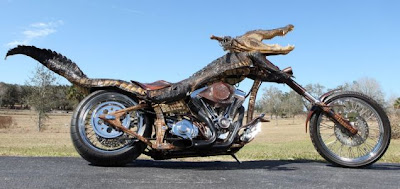
Jim Jablon didn't want his alligator skin to go to waste so he covered his motorcycle and making it the fastest road kill on record. It was given away in a charity fundraiser for an animal rehab center that has rescued dozens of exotic pets, including this albino Burmese python named Arctic.
The skin is detachable but the head is fixed perm-anently into the handlebars and has the speedometer implanted into the back of the skull.
Hand-carved skateboards by Doug McKee
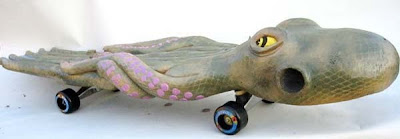
Stingray Skateboard
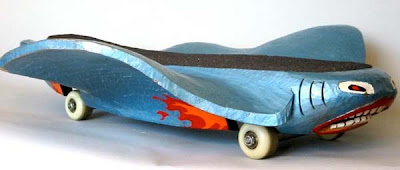
Crocodile Skateboard
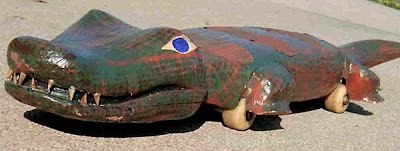
Raven Skateboard
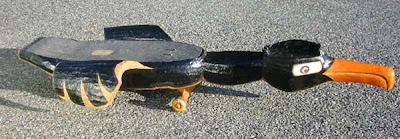
I just found these amazing skateboards by artist Doug McKee of Bellingham, WA who carves skateboards that look like birds, insects, and sea creatures. here is what he had to say:
The process of carving a skateboard takes a bit of time. The piece is carved out of green wood. Which is to say wet, freshly cut wood. Ideally the wood spits its water at you as you carve. I use western red cedar because it is ideal in so many ways. Its light, strong and becomes harder as it ages. It splits easily facilitating carving--but also renders the piece fragile. First it is carved green and carefully hollowed out, then put away to dry. It shrinks radially along the growth rings as it dries. Some material must be left to "true up" or eliminate the distortions caused during drying. When it is dry enough it is finish carved. via Makezine
Future Collectible Cars
My answer: something like a Mustang GT, or Chevrolet Camaro, or Dodge Challenger, running a V8. Even a Pontiac G8.
Because when NHTSA, EPA, and CARB's CO2 and fuel economy regulations kick in full bore, only rich guys will be able to afford a good fashioned American V8. Naturally aspirated, big displacement, big torque.
Geocache Challenge Update: WINNER!
Oliver von Feistmantl on Art Cars
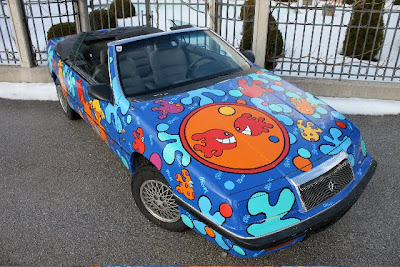
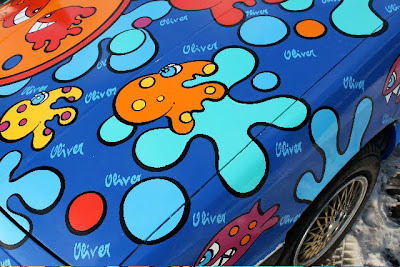
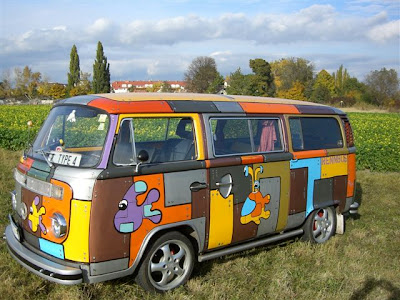
Oliver von Feistmantl is a comic PoP artist from Vienna Austria that paints on pretty much everything, like houses, ships, snowboards, skateboards and even cars.
He started out as a graffiti artist in the 90´s but got arrested, so he decided to concentrate on legal ways to exhibit throughout Europe, Asia, the Caribbeans and NYC.
He makes acrylic paintings and sculptures in all sizes and in 2008 started to paint on a fishing boat in Thailand and in 2009 started to paint on cars.
The 1974 VW-Bus is called the racebus, because he got an engine from a Porsche 911 and was finished in October 2009. The 93 Chrysler Le Baron convertible was finished in 2010 and is the one he currently drives.
He hopes one day to come across a Rolls Royce Silver Shadow because its his personal dream to one day paint that car as well.
Geocache Challenge Update 3: Corrected
The new (and hopefully correct) GPS location of the prize is N42*33.547, W83*12.596
Also, more hints about where it is:
Follow the right side of the field, to where you can see the power transformer.
Follow the path until it comes to a "T".
The prize is hidden behind a large fallen log about 20" off of the trail from the "T".
Shooting Down Mosquitos

Geocache Challenge Update
Here's a hint: the cache is within a 15' radius of the T shaped intersection which forms the last waypoint. It isn't buried, but it is not in "plain view" from the trail.
The True Danica
If somehow, inexplicably, you do win tomorrow, promise us that you'll moon the other racers and scream, "Suck it, losers!"
(Laughs.) I think it'd be really funny if I started winning all the time and became really annoyingly girly and put on lipstick before every race and started wearing heels and stuff like that. I probably can't back any of this up, because I'd feel really uncomfortable and self-conscious and I'd never follow through. But it's a funny idea.
I like her more after reading the interview... her whole bikini-girl-racer image, and the stupid dot com commercials she is doing make her seem very superficial. The interview shows a much more interesting person.Subaru CVT
Really, the only way to sanely drive the Legacy Limited is with the paddle shifters. If you don't use them and leave the car in automatic mode, it's confusing and uncomfortable.
When you launch the vehicle, its revs tend to jump and then stay too high. Because the shift points are gone, something feels off -- though the Legacy is performing exactly the way it was designed. The CVT searches for the most efficient engine speed to produce the power it needs -- this is one of the reasons CVTs provide better gas mileage.
Paddle shifters, faux shift points, on a CVT?
It's Subaru's attempt to make customers feel at home. But it's silly. Instead of trying to fool you into thinking you are driving an automated manual gearbox, automakers should take the time to educate consumers about the benefits of CVTs. And if the unit whines, or the engine revs high longer than people are used to, perhaps what is needed is better noise management. Once people get used to the idea of CVTs, they won't be annoyed at their feel.
Personally, I'm a bigger fan of the dual clutch automated manual designs. They have very good efficiency, and avoid some of the serviceability questions of CVTs. And they can have "real" paddle shifters.
The AutoProphet GeoCache Challenge, Week 2
The coordinates are listed in the original post, here.
NISSAN 370Z Black Edition japanese car pictures (2010)
370Z Black Edition (2010)
- click thumbnails to enlarge or download size 1600 x 1200 pixels -
Just over 40 years ago a motoring icon was born. As the sixties moved into the 1970s, the Datsun 240Z was launched on the US market. American drivers instantly fell in love with the car and sales in that one market alone regularly topped 50,000 units annually. The Z legend had begun.
Now four decades, six generations and well over a million cars later, Nissan is introducing a special celebratory version of the newest two-seater to wear the famous Z badge - the Nissan 370Z.
Inside the Nissan 370Z Black edition there are:
= Unique red leather & suede appointed interior (seats & door trim) with embossed 40th Anniversary logo seats =
= Smooth leather wrapped steering wheel with red stitching =
= Red stitching on the centre cluster, centre console and knee pads =
= Nissan's Connect Premium state-of-the-art combined touch-screen satellite navigation and audio system with USB connectivity =
The exterior of the Nissan 370Z Black can be identified thanks to:
= Dark grey 19" aluminium forged RAYS wheels =
= Eye-catching red brake callipers =
= 40th Anniversary emblem on the back door =
Standard specification means it already has a bespoke BOSE premium audio system, 19-inch forged alloy wheels, Stop/Start button with Nissan's Intelligent Key and a sporting six speed manual transmission with unique Synchro Rev Control technology. The electronically controlled rev matching system ensures perfect 'heel and toe' gear changes every time. A seven-speed automatic version with column-mounted paddle shifts is available as an option.
The Black Edition comes as standard with Nissan's next generation combined audio and navigation system, offering improved ease-of-operation, new and updated features.
At its heart is a high performance Hard Disk Drive (HDD) navigation system that offers customer audio storage capacity of 9.3GB.
Among the many benefits are vastly extended mapping which now includes Turkey, Eastern Europe and Russia, as well as a new easy to follow 3D navigation guidance with improved graphics and a more realistic depiction of the road and landmarks ahead for many of Europe's principle cities. The resolution of the new 7 inch screen is up to four times better than the previous generation system.
Real time traffic information is supplied via RDS-TMC, but quicker operation allows the system to offer re-routing in a fraction of the time.
The new generation system uses a touch-screen interface, maximising both ease of use and safety not only for the navigation, but also for other functions such as Bluetooth phone connectivity and entertainment. It is also possible to operate the system using voice recognition.
On-screen instructions can be displayed in eight different languages including English, French, German, Spanish and Italian - while voice recognition is supported in seven - English, French, German, Spanish, Italian, Portuguese and Dutch.
The new generation navigation system also allows USB connectivity for portable audio devices. Furthermore, DVDs can be played on the centrally mounted navigation screen (when the car is stationary), while external audio and video devices can be connected via the VTR connections that are found in the central storage box.
In terms of its mechanical specification, the Nissan 370Z Black Edition matches the standard 370Z. That means a 3.7-litre 24-valve twin cam V6 developing 328PS and a limited top speed of 155mph and a 0-62 mph time of 5.3 seconds (5.6 seconds for the automatic version). The 2010 model year update means the 370Z is now fully compliant with forthcoming Euro 5 emission legislation.
Exemplary levels of handling and grip are assured by the focused rear-wheel drive chassis which features fully independent suspension, powerful upgraded brakes and precise speed sensitive power steering.
Since its launch in June 2009, more than 1,050 examples of the Nissan 370Z have been sold across Europe, an exceptional achievement for a niche product in extremely challenging market conditions. The car's largest market to date has been the UK, followed by France and Germany.
"The 'story of Z' is full of positives, with success not just in the sales charts all over the world but on racetracks and at award ceremonies, too. The Nissan 370Z Black Edition is a fitting tribute to a great car," said Vincent Wijnen, Nissan's European Vice President for Marketing.
Customers can order the Nissan 370Z Black Edition from all Nissan High Performance Centres and throughout the dealer network with deliveries starting in April 2010.
Prices start from - £33,645 for the manual and £35,045 for the automatic transmission (prices include £750 showroom tax which comes into effect on 1 April 2010).
Auto insurance Information http://aarp.thehartford.com/
|
| Choose NISSAN by MODELS |
INFINITI FX Limited Edition | japanese car pictures (2010) |
pictures, photos, wallpapres, specifications, review and car insurance informations.
FX Limited Edition (2010)
- click thumbnails to enlarge or download size 1600 x 1200 pixels -
The Infiniti FX Limited Edition will be rare indeed. Availability has been strictly limited to just 100 units across Western Europe. Based on the already dramatic looking FX37S and FX50S, the Limited Edition features striking Black Obsidian 'Scratch Guard' paintwork as standard, with equally distinctive Moonlight White pearl metallic available as an option. Unique 21 inch 'Turbine' design alloy wheels are finished in dark Graphite, as are the radiator grille, air vents and roof rails.
The Infiniti FX Limited Edition's interior is equally breathtaking. Opening one of the doors reveals illuminated 'Infiniti' entry guards and a carefully co-ordinated combination of the finest natural materials, including supple Graphite leather upholstery with contrasting stitching and a luxurious Alcantara® headlining. Genuine Carbon fibre is used extensively on the dashboard, centre console and door panels, replacing the standard cello flame maple wood veneer. Completing the Infiniti FX Limited Edition's extensive standard specification, Infiniti's state-of-the-art Connectiviti+ technology package provides a fully integrated navigation, communication and entertainment system including an 11-speaker Bose® Premium Sound System, the Michelin Guide, full iPod connectivity and a 10GB music box with Gracenotes database. An option on the standard FX37S, this is joined on both the V6 and V8 engined Limited Editions by Infiniti's unique Around View Monitor.
Exterior styling
With its breathtaking combination of sports car proportions and muscular SUV stance, the FX is an unmistakable performance luxury crossover. The Infiniti FX Limited Edition accentuates these unique design qualities with a choice of standard Black Obsidian 'Scratch Guard' paint or optional Moonlight White pearl metallic, together with dark smoked headlight surrounds that give the Infiniti FX Limited Edition a more distinctive 'face'.
Further drama comes courtesy of the Infiniti FX Limited Edition's 'Turbine' design alloys wheels, so called because the spokes of the wheels are shaped in such a way as aid the flow of cooling air to the sports brakes. Uniquely finished in dark graphite grey - together with the distinctive 'double-wave' radiator grille, air vents and roof rails - they are fitted with 265/45 R21W tyres and fill the wheel arches to perfection.
Interior environment
The Infiniti philosophy of Modern Luxury is exemplified in the Infiniti FX Limited Edition's stylish and comprehensively appointed interior. From the supple Graphite leather upholstery complete with quilted stitching, to the opulent Alcantara® trimmed headlining and roof pillars and wool carpets, only the finest natural materials are used. Illuminated 'Infiniti' door entry guards are also unique to the Infiniti FX Limited Edition.
The extensive use of genuine carbon fibre across the dashboard, centre console and door panels provides an appropriately high-tech contrast to the soft-touch natural materials and provides a fitting backdrop to the Infiniti FX Limited Edition's standard Connectiviti+ infotainment system. Employing the very latest Hard Disk Drive (HDD) technology it features a fully integrated satellite navigation system with 42-country, Europewide coverage and, in a world-first collaboration with Michelin Green Guide, a database of some 22,000 addresses, which enables the location and booking of leading hotels and restaurants while on the move.
The Connectiviti+ multi-media system also includes a powerful 11-speaker Bose Premium Sound System, a 10GB direct record Music Box that can store up to 300 albums' worth of your favourite music, plus a DVD player, USB port for MP3 players and Bluetooth hands-free mobile phone connectivity.
Additional standard equipment includes electrically adjustable, heated and ventilated front seats, an electric sunroof, Infiniti's keyless entry and start system, and magnesium paddle shifts that work in conjunction with the seven-speed automatic gearbox. Also included is startling performance that sees the V8 powered Limited Edition speeding to 62mph in just 5.8 seconds with the V6 version only a second behind. Traction in all weathers is assured by intelligently controlled, all-wheel drive.
Infiniti FX technical highlights
= Fusion of sports car and SUV
= Choice of 320PS 3.7-litre V6 or potent 390PS 5.0-litre V8
= Standard seven-speed automatic transmission with paddle shift
= Intelligent All-Wheel Drive
= Suspension with active Continuous Damping Control (CDC)
= Class leading handling
= Standard Rear Active Steer (RAS) on V8-engined model
= Lightest SUV in its class
= Advanced features including Around View Monitor
= EuroNCAP 5 star safety rating
Auto insurance for Washington drivers http://www.pemco.com/auto/default.aspx
|
The Truth About Tango
What WR doesn't bother telling us is that the Tango is not really a production vehicle. It is sold as a kit. After you plunk down your $108,000, you get a shipment of a rolling chassis. Followed later by a shipment of missing parts that you can bolt on yourself, or have one of the Commuter Cars guys come out and install for you.
And if you live outside of the Spokane, WA area, where do you go if you need your Tango serviced? I assume you will have to have a Commuter Cars rep fly out to you.
There is currently one street legal, mass produced, electric-only vehicle in the U.S., and that is the Tesla Roadster. Everything else is, at this point, either vapor-ware or a toy.
Transportation Secretary: "Stop Driving Recalled Toyotas"
Wow.
LaHood needs to be more careful what he says--he could cause some real public relations problems, for himself and for Toyota.
While sticky throttle pedals are a serious problem, the failure mode is rare, and completely controllable if the driver pays attention and keeps a cool head.
To repeat:
1) Press brakes firmly
2) Put the gear selector in N
3) Pull over
If 2) is a problem for some reason, you can turn off the motor.
HONDA Accord Crosstour (2010) japanese car pictures
The Honda Accord Crosstour's styling and body construction evolved from the sophisticated foundation of the Accord Sedan. Architecturally similar to the distinctive shape of the Accord, key differences can be found throughout the entire body. No exterior panels are shared with any other Accord. The most noticeable differences include the overall height of the body from the floor to the roof and the obvious design differences in the rear of the vehicle to accommodate the sloped roofline and the tailgate.
The heightened body dimensions combined with increased ground clearance result in a commanding view of the road and a comfortable hip point for ease of entering and exiting the vehicle. Structural technology includes the Advanced Compatibility Engineering™ (ACE™) body structure, an exclusive body design that enhances occupant protection and crash compatibility in frontal crashes. Extensive application of high-strength steel (46 percent) contributes to high levels of torsional and static rigidity, reduced weight, and enhanced safety potential. Aerodynamic performance is increased through strategic use of under-body covers and strakes.... Features >
Automobile Insurance and Other Types of Vehicle Insurance http://www.progressive.com/
|
features | HONDA Accord Crosstour (2010)
Accord Crosstour (2010) FEATURES:
Exterior Styling Concept
The exterior styling builds on the Accord's familiar character lines and adds a bolder front grille complemented by a durable lower-body appearance, wedge-shaped D-pillars and an aggressive rear stance. The designers sought to build on the Accord's style that is already powerful, bold and sophisticated. Like the Honda Accord Sedan, the Accord Crosstour's design is both sharp and strong, with a powerful-looking stance. Starting at the front, the Honda Accord Crosstour's front fascia is enlarged and raised for dynamic toughness, and incorporates a wider and taller 6-point grille with large, horizontal slats surrounded by sharp and wide projector beam headlights. Well-defined wheel arches convey a strong stance and muscular tension. The fender lines appear broadened, like strongly muscled shoulders, with prominent character lines that sweep along nearly the entire body sides, subtly transitioning from an inverse line to an external line. Besides providing visual distinctiveness, these character lines communicate strength and structural depth. The flowing roofline narrows smoothly into the rear of the vehicle to create an aggressive-looking design, concealing a unique cargo area that can adapt to large objects that exceed the capacity of a normal sedan.
Body Construction
Increased rigidity enables enhanced vehicle dynamics, ride comfort and driving quietness. The Honda Accord Crosstour is constructed of 46 percent high strength steel (340 grade or above) to create a strong, yet lightweight body with high rigidity and enhanced safety. The ACE Body structure further enhances frontal collision compatibility between vehicles with different bumper heights. The Maximum Efficiency Floor (MEF) design is comprised of a network of longitudinal rails, floor cross-members and pillar reinforcements that carry heavy loads to enhance crash safety, handling and packaging efficiency. High tensile strength steel tubular beams inside the door structure provide additional intrusion resistance.
Noise, Vibration and Harshness (NVH) Reduction Features
The Honda Accord Crosstour is designed to drive exceptionally smooth and with reduced noise intrusion into the cabin. To accomplish this, the vehicle approaches NVH reduction from two primary directions - traditional insulation in the floor, doors and firewall; and active systems that work with the engine and audio system to cancel certain types of unwanted engine noise. A triple door-seal system is used to minimize wind and road noise. Strategic use of insulation in the rear fender wells also minimizes road noise.
Aerodynamic Enhancements
Aerodynamic performance is increased through the use of body under covers, a deflector under the front bumper, front strakes, the optimum inclination of the tailgate and an effective rear spoiler.
Ground Clearance
The ground clearance for the majority of the underbody area measures 8.1 inches and contributes to the Honda Accord Crosstour's commanding presence compared to the Accord Sedan. The front strakes represent the lowest point under the vehicle at 6.0 inches (the official ground clearance number for EPA measurement purposes).
Active Control Engine Mounts
The Active Control Engine Mount (ACM) system is used to minimize the effects of engine vibration caused by the VCM system when cylinders are deactivated. During cylinder deactivation, the Powertrain Control Module (PCM) instructs the ACM actuators to move in concert with the engine motions to effectively cancel the vibrations inherent to cylinder deactivation. Inside the cabin, the audio system-based Active Sound Control (ASC) further minimizes any unwanted sound relating to the function of the VCM system. (Please see the Interior section for more information.) Together, these innovations help make the implementation of fuel saving technology transparent and seamless to the driver.
Glass and Visibility
The Honda Accord Crosstour was designed to provide excellent outward visibility, improving the comfort and convenience for all occupants. A large greenhouse creates excellent outward visibility. Deeply tinted privacy glass is used in the rear side doors, wedge-shaped rear quarter windows and rear tailgate.
Tailgate
The Honda Accord Crosstour's front-hinged tailgate design creates a wide opening into the vehicle of 38.5 inches (980mm) and a low lift-in height of 28.4 inches (721 millimeters). The hinge design is configured so that the user does not have to step backwards when the door is opening or shutting. The tailgate includes a large upper window and a smaller lower window for increased rearward visibility at lower sight angles. The lower window allows for objects like a 3.3-foot (1 meter) tall parking lot pole to be spotted at distances as close as 5.3 feet (1.6 meters). Comparatively, some CUV designs that lack a lower rear window require approximately 6.5 feet or more to spot the same 3.3-foot pole. The upper tailgate glass incorporates an intermittent rear wiper and washer nozzle. An electric defogger system is incorporated into the upper and lower glass sections.
The tailgate locks and unlocks with the interior's door locks. To open, an electronic switch under the license plate awning releases the tailgate when the vehicle is unlocked. For ease of closing, a grip handle is located under the tailgate base. The tailgate can be opened in tight parking situations, requiring a minimum of 5.9 inches of space between the leading edge of the tailgate and a potential obstruction like a nearby vehicle or wall. Two gas-filled struts support the open tailgate.
Headlights and Taillights
The Honda Accord Crosstour is equipped with halogen projector-beam headlights for low beam illumination and conventional reflective halogen high beam headlights. Projector-style headlights provide a distinctive and sporty appearance with a bright, focused beam for a superior, even distribution of light compared to conventional reflector lens designs. The standard fog lamps are integrated into the front bumper. The taillights convey a deep three-dimensional appearance with layered inner lines that wrap from the back of the vehicle into the fenders. A clear lens for the backup light punctuates the overall red design. The taillight housings integrate a side reflector and turn signals in addition to the running lamps and the stop lights.
Door Design and Construction
The Honda Accord Crosstour's doors are designed to operate with solid precision with a convenient three-stage detent hinge. Additional premium features include triple seals in the bottom of the door structure to better insulate the cabin from road noise. Triple seals also serve to keep moisture, dirt and road grime away out the kick panel area - a space that can sometimes come into contact with clothing while entering or exiting the vehicle. All door handles are soft to the touch underneath to improve operating comfort.
With the key inserted, the door lock cylinders can raise and lower the windows and open/close the moonroof by turning clockwise for up and counter-clockwise for down. The unlock button on the key fob will lower the power windows and open the moonroof when depressed for three seconds and then continuously held.
An automatic door locking/unlocking system is customizable by driver preference. Automatic locking can be linked to vehicle speed reaching 10 miles per hour (15 km/h), or the gear shift lever shifting from park, or it can be deactivated entirely.
Automatic unlocking, configurable to the driver's door or all doors, can be linked to the ignition switch being turned to the off position, or the gear shift lever being positioned in the park position, or it can be turned off entirely. The factory default for locking is linked to vehicle speed. The factory default for unlocking is linked to the gear shift lever and unlock activation for the driver's door only.
Side Mirror
The vehicle's side mirrors are aerodynamically optimized to prevent wind noise and minimize turbulence. When the driver puts the transmission in reverse on the Honda Accord Crosstour EX-L model, the driver or passenger-side mirror can tilt down (depending on left/right/off mirror switch position) to reveal curbs and ground level obstacles. The Honda Accord Crosstour EX-L model includes mirror position memory linked to the driver's seating profile (activated with the key fob or the controls near the driver's door release). All models feature heated side mirrors as standard equipment.
Moonroof
To tilt or slide the moonroof the driver or front passenger needs only to fully press the ceiling-mounted switch once (instead of pressing and holding it for several seconds). The moonroof fully opens or closes automatically. However if the operator wishes to only partially open or close the moonroof (such as to achieve partial ventilation), a lighter touch yields fully manual control. The moonroof can also tilt to provide ventilation. An auto-reverse feature is built in, helping to ensure that the moonroof will not forcefully close if someone's hand or arm is positioned in the path of the moonroof. If an obstruction is detected, the moonroof mechanism will reopen the moonroof.
Chassis
The 2010 Accord Crosstour leverages the benefits of a premium chassis design for rewarding and sophisticated handling dynamics. A double-wishbone front suspension and multi-link rear suspension allow for both a smooth ride and world-class levels of performance that is equally at home on a curvy road, long stretches of interstate highway or in inclement weather. Ground clearance of 6.0 inches enhances capability in snowy conditions and broadens access to more roads off the beaten path. Standard features include Vehicle Stability Assist™ (VSA™), commonly referred to as Electronic Stability Control; 4-wheel disc brakes; and stabilizer bars front and rear.
Front Subframe
A front "floating" subframe design is used on the Honda Accord Crosstour. A welded-steel subframe secured to the unit body's longitudinal rails supports the Accord's engine, transaxle, transfer case, steering gear and front suspension. The front of the subframe assembly is designed for enhanced stiffness with minimal weight penalties and uses four tuned rubber mounts to isolate the subframe from the main body structure, i.e. it is "floating."
A stiffener located under each subframe attachment fastener helps to further stabilize the assembly, thereby achieving linear handling and braking performance. The subframe includes two Active Control Engine Mounts (ACM) that counteract the inherent vibration created by the Variable Cylinder Management (VCM) system, plus one rubber isolator transmission mount. The "floating" mounts are strategically positioned to counteract noise and vibration while reducing the transmission of engine noise and vibration to the passenger compartment.
Double Wishbone Front Suspension
Widely spaced upper and lower wishbones give precise suspension action, with the coil-over spring and shock absorber units free of the binding caused by the side-loading inherent in some less sophisticated strut-type designs. The Honda Accord Crosstour's front suspension is a modified version of the double-wishbone system used on the Accord Sedan and Coupe. Stabilizer bars, springs and damping rates have been optimized to provide the best combination of ride and handling. The front lower control arms are forged steel and connect to a stamped steel box-section sub frame. The stamped-steel upper control arms connect to a forged-steel knuckle.
Progressive valve nitrogen gas-filled coil-over shock absorbers integrate an internal rebound spring. When cornering, the internal rebound spring allows the shock absorber to exert additional force on the inside wheel's coil spring to help counteract wheel lift in certain situations. This premium shock absorber design helps to improve both ride comfort and responsiveness. Ultimately, tire-to-road adhesion is enhanced.
Rear Subframe
The rear subframe, which supports most of the rear suspension and the rear axle drive unit, is made of high-strength steel for high stiffness and minimal weight. The shape of the rear subframe is equally important - it must accommodate the drivetrain components for the available Real Time 4WD system and the multi-link rear suspension. For excellent ride and handling characteristics, the subframe attaches to the unit body at four widely spaced, rubber-isolated, mounting points. Rear-suspension components, especially the springs and shock absorbers, are as compact as possible to facilitate a wide, flat, load floor and to leave room for both a spare tire and a fuel tank. The rear axle drive unit (if equipped) is mounted to the subframe by means of rubber isolators to block powertrain noise and vibration from the passenger compartment.
Multi-link Rear Suspension
The Honda Accord Crosstour's rear suspension is a compact, multi-link layout for excellent ride and handling, minimum weight and optimum packaging. Wheel travel is a generous 4.3 inches in compression and 3.7-inches in rebound. The three links that position each rear wheel laterally run between the knuckle assembly and the subframe. Progressive valve nitrogen gas-charged shock absorbers attach from a low point on each knuckle to a highly rigid attachment point on the unit body.
The knuckles are an "in-wheel" design to optimize suspension geometry and packaging efficiency. Bushing compliance provides a modest toe-in effect in response to substantial cornering and braking loads to enhance overall stability. The rear knuckles are made from aluminum and help to reduce unsprung weight for quick suspension responsiveness. Optimized high rigidity bearings accommodate the additional forces of the four-wheel-drive system. Coil springs, dampers and a stabilizer bar are tuned for the best combination of ride and handling. Rear subframe mounts and lateral control link bushing rates were adjusted to create a discrete level of lateral force steer at the rear axle.
Power Rack-and-Pinion Steering System
The Honda Accord Crosstour features rack-and-pinion steering with a speed-sensitive, variable power assisted system. For optimum steering feel, the variation in power assist is linear with a smooth transition from low to high boost.
The system uses heat-resistant rubber mount bushings, high-pressure die cast aluminum gear housings, a low friction material rack guide for good on-center feel and a damper valve to reduce steering wheel vibration. The Honda Accord Crosstour provides a turning diameter of 41.7 feet, curb to curb. The rack-and-pinion steering wheel gearing creates a constant ratio of 15.2:1 and requires 2.76 turns lock-to-lock.
4-Wheel Disc Brakes with Anti-lock Braking System (ABS)
Consisting of four-wheel disc brakes and four-channel anti-lock brakes, the Honda Accord Crosstour braking system is tuned for stable and linear braking forces. The Honda Accord Crosstour's ventilated front brake rotors are 11.7 inches in diameter with a thickness of 1.1 inches, while the solid rear rotors are 12.0-inch diameter units with a thickness of 0.4-inches. The rear brakes use a drum-in-disc configuration for the parking brake. Dual-piston cast iron brake calipers are used in front and single-piston cast iron calipers are used in the rear. A single stage vacuum booster consists of one 10.5-inch diameter booster chamber.
For optimum performance with widely varying loads, Electronic Brake Distribution system (EBD) technology monitors braking force and adjusts front-to-rear brake effort to achieve maximum braking performance and stability. At the rear, a select-low braking strategy is used to help maintain directional stability in slippery driving.
In the event one rear wheel verges on lock-up, triggering a pressure modulation at that wheel, brake pressure is also diminished at the adjoining wheel to help preserve the rear axle's lateral stability. The parking brake is set by a hand brake lever in the console.
Wheels and Tires
The Honda Accord Crosstour is offered with two wheel and tire combinations. The Honda Accord Crosstour EX comes with 17x6.5-inch aluminum alloy wheels and 225/65R17 102T all-season tires. The Honda Accord Crosstour EX-L comes with larger 18x7.0-inch aluminum alloy wheels and 225/60R18 100H all-season tires. Wheels feature a five-lug pattern with 55mm offsets. For maximum cargo capacity, a space-efficient compact spare is carried under the rear cargo floor.
Fuel System
The 18.5 gallon fuel tank is molded of high-density polyethylene for low weight, freedom from corrosion and impact resistance. It is positioned ahead of the rear wheels and over the propeller shaft (if equipped) to help guard against collision damage. The shape of the tank is designed to diminish the likelihood of sloshing-fuel noise. The polyethylene filler pipe and fuel lines are lightweight, and resistant to corrosion and fuel vapor losses. A high-efficiency fuel pump is housed inside the fuel tank. The fuel-filter is a lifetime design that never needs replacement. The shape of the fuel tank is modified for vehicles with Real Time 4WD to accommodate the propeller shaft and dual exhaust pipe, yet retains the same capacity as 2WD models.
Interior
The Honda Accord Crosstour is designed to offer a comfortable, high quality and premium environment for up to five passengers along with enhanced cargo functionality that can conveniently accommodate active lifestyles. Compared to the Accord Sedan and Coupe, the Honda Accord Crosstour provides a uniquely higher step-in height and hip-point for ease of entry and exit, which also results in a commanding view of the road.
The cargo area incorporates useful and versatile features that make configuring the vehicle for people or large items a simple operation. Levers near the interior fender wells, conveniently accessible from the tailgate opening, allow for one-touch conversion of the rear seats into the floor for quick access to the 51.3 cubic feet of maximum-possible cargo space. An 8.4-inch deep under-floor hidden removable utility box adds 1.9 cubic feet of storage. The carpeted lid of the cargo box can be reversed to a plastic side for storage of wet or dirty items. Honda Accord Crosstour EX-L models include a cargo privacy cover.
Styling Concept
"Premium and active" represents the dual role functionality of the Honda Accord Crosstour's interior design. Consistent with all Accords, a variety of design techniques were used to enhance the feeling of width and space in the passenger cabin to express premium and accommodating quality. The inset sculpting of the instrument panel along with a wide center console increases the sense of roominess. Intuitively grouped controls for the audio, climate and available navigation system are designed to operate with solidity and precision.
Two interior color combinations are available. The charcoal black interior is intended to convey a stylish and sporty environment and features a monochromatic black instrument panel divided with wood trim-appearance highlights. The ivory interior is intended to create a sophisticated and bright ambiance and features a two-tone instrument panel with a black upper segment and tan lower segment. Wood trim-style accents on both color combinations divide the upper and lower portion of the instrument panel.
Interior Packaging Concept
The Honda Accord Crosstour interior packaging concept is divided into two distinct zones for premium passenger accommodation and versatile cargo capabilities. The passenger zone seeks to provide occupants with sophisticated styling and advanced features similar to all Accord body styles. The cargo zone continues the premium theme with highly visible application of quality materials above the floor line, then adds more rugged versatility beneath the floor.
Instrument Panel
The driver's instrument cluster includes two large analog meters for the speedometer and tachometer, each surrounded by silver trim rings for a premium sporty appearance. The Honda Accord Crosstour meters use blue illuminated pointers for a premium appearance. The 8000-RPM tachometer and 160-mph speedometer are flanked by temperature and fuel gauges. Below the meter array is an LCD display that can show odometer, Trip A or Trip B functions, outside temperature, and maintenance alerts.
The center panel has been carefully designed for maximum visibility and ease of use. A central display is mounted at the top of the center stack for good visibility, and the controls are mounted lower for easier reach. Switches for the audio system, climate controls and navigation system (if equipped) are grouped together in corresponding zones differentiated by function type. The button positions and size are prioritized by frequency of use. Switchgear is flush mounted with high-grade materials for an upscale appearance and feel. For further differentiation, climate control buttons appear light gray and audio controls appear black.
The Honda Accord Crosstour EX and EX-L (non navigation) three-line central display features a digital clock; audio mode indicator; station and broadcast contents information for FM, XM (on EX-L), track and time information for CD and the EX-L's USB-connected media; dual climate control temperature readouts and a digital compass. The Honda Accord Crosstour EX-L with navigation integrates an 8-inch screen in place of the three-line display and an interface dial down low on the center panel within easy reach.
Underneath the center display are two movable climate control vents, the emergency flasher switch and a passenger-airbag off light. Below the vents are the HVAC controls. Audio-system controls are located in a separate row and feature larger switches that are easier to identify at a glance. Honda Accord Crosstour EX and EX-L (non-navigation) models also have an interface dial in this location, flanked by Menu and Cancel switches. The dial is rotated to select among different on-screen items. Pushing the center button selects the highlighted item.
Steering Wheel
The 3-spoke steering wheel on the Honda Accord Crosstour (leather wrapped on EX-L) is intended to create a sporty feeling. Steering-wheel mounted audio and cruise-control buttons include Mode, Volume and Channel, plus Cruise, Cancel, Set/Decelerate and Resume/Accelerate. Honda Accord Crosstour EX-L models add buttons for the Bluetooth® HandsFreeLink® telephone interface. In models equipped with the navigation system, the steering wheel also features buttons for navigation voice control activation. The tilt and telescope range for the steering column, along with seat height adjustment range, enhances comfort for a wide array of driver sizes.
Dual-zone Air Conditioning with Air Filtration System and Humidity Control
The Honda Accord Crosstour is equipped with dual-zone automatic climate control as standard equipment. The primary heating, air conditioning and ventilation (HVAC) controls include individual controls for temperature, fan speed, vent selection (center, floor and defogger vents), rear electric defogger and fresh or re-circulated air. To maximize rear passenger comfort, the Honda Accord Crosstour includes vents in the rear console (identical to the new vents added to Accord Sedan EX and EX-L models for 2010). The airflow is connected to the front center vents. The dual-zone automatic climate controls maintain a user-selected temperature based on the driver's or front passenger's preferred settings for temperature. The dual-zone aspect of the automatic climate control allows the driver and front passenger to select different temperatures.
The automatic climate control on models equipped with the Honda Satellite-Linked Navigation System benefit from GPS-linked, solar-sensing technology that intelligently modifies the temperature setting on the side of the vehicle facing the sun.
Based on its continuously updated vehicle position information, the navigation system determines the position of the sun relative to the driver and passenger and then increases or decreases the temperature accordingly. When in AUTO mode, this information is combined with input from the solar sensor located on top of the instrument panel to automatically adjust the temperature from side to side as needed in order to compensate for asymmetrical solar heating.
To provide greater operating efficiency while maintaining a comfortable interior climate, the Honda Accord Crosstour partially mixes cool cabin air with fresh air in the blower to reduce compressor operation by up to 20 percent (compared to operating exclusively on exterior air).
To prevent the compressor from being excessively operated, the Honda Accord Crosstour's climate control system has a cabin humidity sensing system. This control system provides greater passenger comfort and minimizes the time the air conditioning runs. When set to operate in AUTO mode, a temperature and humidity sensor located in the front of the passenger cabin monitors the interior climate. If the system determines that there is a low probability of window fogging, it maintains a comfortable humidity level. If the system determines that potential window fogging conditions exist, it changes the climate control parameters to help keep the windows clear.
Front Seats
Designed to provide both long term comfort in the center and firm lateral support on the sides, the front seats are identical to those found on the Accord Sedan. The seats include active head restraints that help reduce the likelihood of neck injury in the event of a rear collision. The cloth seating surfaces on the Honda Accord Crosstour EX include 10-way power adjustment (including lumbar support) for the driver and 4-way power front passenger-side seat. The Honda Accord Crosstour EX-L upgrades to leather-trimmed seating surfaces and adds a position memory function for two drivers. The memory function is activated by either the key fob or by the panel located next to the driver's door handle, and it also recalls the preferred side mirror settings.
Center Console
The center console provides 5.3 liters of storage and functions as a wide armrest for the driver and front passenger. A spring system supports the operation of the cover, which doubles as the center armrest. In addition, 19 CDs can fit inside. The armrest slides fore and aft for improved comfort for drivers of different heights.
Located inside the center console is an auxiliary input jack (aux-in) that supports a personal audio player connection to the vehicle's audio system. A 12-Volt DC power point is included inside the console. Plugging a portable audio device into the aux-in jack automatically sets the volume at a preset level; when the device is unplugged, the volume resets to its previous level. The Honda Accord Crosstour EX-L adds a USB Audio Interface in the center console.
60/40 Split Rear Seats with One-touch Fold Down Levers
The rear seats capitalize on the wide stance of the Honda Accord Crosstour and can accommodate up to three passengers. Each rear passenger seating position has a head restraint. The 60/40 split allows for partial or full access to additional cargo space depending passenger or cargo priorities. A folding center armrest is integrated into the seat and includes two beverage holders. In the cargo area, two one-touch release levers are located near the tailgate opening sides for one-handed fold-down operation of the seats into the floor. The seats create a flat surface when folded down and do not require the removal of the head restraints. Two Lower Anchors and Tethers for Children (LATCH) positions are included in the outboard seating positions. Three child seat anchors are provided on the rear seat backs.
Cargo Area
The rear cargo area supports the "active" role of the Honda Accord Crosstour and demonstrates how thoughtful engineering can maximize a limited amount of space. Durable level-loop carpet lines the cargo area to help cushion contents. A polished metal kick plate at the base of the cargo area opening resists scuffing and appears upscale yet durable. In standard configuration with rear seats upright, the cargo area provides 25.7 cubic feet of cargo space above the floor and an additional 1.9 cubic feet of space below the floor. With the rear seats folded forward, the total above-floor cargo volume expands to 51.3 cubic feet. The carpet-covered plastic lids discretely conceal the Hidden Removable Utility Box and the under floor side bins that can be reversed to create an all-weather, wipe-able cargo area. The carpeted side creates a premium look and offers a "soft" option for transporting "premium" items, while the plastic side is ideal for transporting dirty and/or damp items. Two cargo tie-down points are provided on the floor near the middle of the wheel wells and two more are provided on the rear wall of the cargo area. A 12-Volt outlet is located on the driver's side rear wall of the cargo area.
Powertrain
The Honda Accord Crosstour comes standard with a 271 horsepower V-6 engine, a 5-speed automatic transmission and is available with the company's innovative Real Time™ 4WD system. The 3.5-liter, 24-valve SOHC i-VTEC powerplant with Variable Cylinder Management (VCM) that builds on technologies that have been developed and refined on previous Honda vehicles. With its 60-degree V-angle, the Accord's V-6 engine is inherently very smooth and has compact overall dimensions that allow efficient packaging within the vehicle. The automatic transmission includes a new G-force hold control feature along with an RPM rev-matching featuring when downshifting.
Engine Architecture
The Honda Accord Crosstour's engine is an advanced 3.5-liter, SOHC, 24-valve, 60-degree, V-6, aluminum-block-and-head design that is compact, lightweight and powerful. The i-VTEC valvetrain and high efficiency intake manifold optimize cylinder-filling efficiency across a wide range of engine speeds. Low-restriction intake and exhaust systems, a 10.5:1 compression ratio and roller-type rocker arms further aid efficiency and power delivery across a broad RPM range.
The Honda Accord Crosstour's V-6 has a die-cast lightweight aluminum alloy block with cast-in-place iron cylinder liners. Made with a centrifugal spin casting process, the thin-wall liners are high in strength and low in porosity. The block incorporates a deep-skirt design with four bolts per bearing cap for rigid crankshaft support and minimized noise and vibration. Both the block and caps are heat treated for greater strength.
A forged steel crankshaft is used for maximum strength, rigidity and durability with minimum weight. Instead of heavier nuts and bolts, connecting rod caps are secured in place with smaller, high-tensile-strength fasteners that screw directly into the connecting rod. Short-skirt, cast-aluminum, flat-top pistons are notched for valve clearance and fitted with full-floating piston pins.
Like other Honda V-6 powerplants, the Accord Crosstour V-6 cylinder heads are a single-overhead-camshaft design, with the cams driven by the crankshaft via an automatically tensioned toothed belt. Made of low-pressure cast, low-porosity aluminum, each cylinder head incorporates an integrated exhaust manifold to reduce parts count, improve flow and optimize the location of the close-coupled catalyst on each cylinder bank.
The cylinder head employs four-valve combustion chambers, the best approach to optimum performance with excellent fuel efficiency and very low emissions. Valves are clustered near the center of the bore to minimize combustion chamber volume and to provide ample squish area. The 10.5:1 compression ratio helps maximize thermal efficiency, power output and fuel efficiency. One centrally located camshaft per cylinder bank is driven by a fiberglass-reinforced toothed belt. Head gaskets are made of high-strength materials to contain combustion pressures.
Safety
The Honda Accord Crosstour integrates a wide range of sophisticated safety technology that includes the Advanced Compatibility Engineering™ (ACE™) body structure and dual-stage, multiple-threshold driver's and front passenger's airbags (SRS); driver's and front passenger's side airbags with passenger-side Occupant Position Detection System (OPDS); and side curtain airbags with a rollover sensor. The ACE body structure is an exclusive body design that enhances occupant protection and crash compatibility in frontal crashes.
Advanced Safety Technology
Inside, every Honda Accord Crosstour incorporates side-curtain airbags and a driver's front side airbag and a passenger front side airbag with Occupant Position Detection System (OPDS), along with active front head restraints that are designed to help reduce the severity of neck injury in the event of a rear collision. Additional standard safety features include dual-stage, multiple-threshold front airbags, an Anti-lock Brake System (ABS) with brake assist, front seatbelts with automatic tensioners and load limiters, and a pedestrian injury mitigation design in the front of the vehicle. Daytime running lights are also standard equipment. Pictures >
Automobile Insurance and Other Types of Vehicle Insurance http://www.progressive.com/
|






